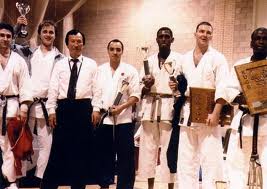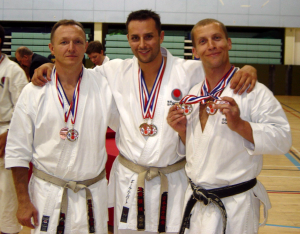Main Menu
Latest Blog Entry
User login
Twenty Years ago today
The streets are paved with gold…
Twenty years ago today I stepped aboard the National Express bus from Taunton to start my new life. I had a new job as a fitness instructor at the Scandic Healthstyles Club in Victoria, London. I had moved so I could train at the Marshall Street Karate Dojo.
I had a 12-8 shift, a rucksack on my back and nowhere to sleep planned that night. I arrived at my new job hot and sweaty, took a shower, tried on my new uniform and got stuck in.
After work, I got a room in a local hostel for a week, until I could find a place to rent. Oh, the joys of being young.
The work at Scandic was very rewarding, there was a great team of young people and owners (Dave and Jeanne Sheriff) who wanted to deliver great service to their customers. I was encouraged to study for the ACSM heath/ fitness instructor certification, as well as other courses.
The facilities were minimal, the toilets kept flooding, but we were striving to help our customers improve their health and fitness.
I bore in mind the advice given to me by my mentor Roy Parsloe “Have empathy with your customers”. Twenty years down the line, that advice is more relevant than ever.
I was earning the princely sum of £8000 p/a. which gave me enough money to live, eat and pursue my other passion.
Training at Marshall Street
 In February of 1993 I had competed in the Southern Region Championships and saw my grading examiner (Sensei Ohta) coaching a team of ugly looking behemoths who were kicking the bejesus out of everyone.
In February of 1993 I had competed in the Southern Region Championships and saw my grading examiner (Sensei Ohta) coaching a team of ugly looking behemoths who were kicking the bejesus out of everyone.
Until then, I didn’t realise he had a club. I made my decision there and then to move to train with him.
The Marshall Street dojo was renowned as being one of the best in the country. I went in as a brown belt, and left as a 4th Dan black belt 11 years later. The first 6 months consisted me of learning to duck and dive in order to survive.
Sensei Enoeda was the senior instructor and his lessons were brutally fast and furious. The wooden floor got slippy with either sweat in the summer, or condensation in the winter. I had to contend with the floor, the lesson and the opponent. The learning curve was vertical.
But, in order to be the best, you have to train with the best: you have to get into the “Ugly Spaces” where the big, nasty dogs lie.At no point in my training at Marshall Street did I feel comfortable or safe. The dojo was at the top of the building and you had to walk up 100 stairs to get there. We didn’t know who was teaching, or who else was going to be in the class.
In my first 4- 5 years there, I was trying to make the team for competitions. I turned up to every squad session, either run by Sensei Enoeda, Sue Waughman, Elwyn Hall or Gary Stewart. “Train hard, fight easy” was never so true. There was no “team” atmosphere: instead it was a bunch of silverback gorillas bickering, squabbling and bashing each other.
One particular session on a Saturday morning involved two hours of sparring, then Elwyn deciding to get us to do the bleep test. I stopped at level 15, feeling quite tired and having gone 2 levels further than anyone else (we all did it in bare feet in our gis.). From that moment Elwyn treated me with a bit more respect (although I was still his preferred punch bag).

A rare smile from me
But, when it came to competitions, we lined up opposite the “Liverpool Red Triangle” or the “Leeds Academy” united in trying to beat them.
I never lost a fight in my first 10 years of competing for Marshall Street, despite being up against some big hitters. I was more scared of my team mates and Sensei Enoeda than the opposition! (Picture is me and my 4 medals at last National Championships with team mates Paul Herbert & Paul Steadman).
I was lucky enough to train there when there were 7 or 8 really nasty fighters, who were also good athletes, training regularly. Not only did those fighters make each other better, all the rest of us improved as a result of the training environment.
You had to move quick, or you got hit… hard. Going into competition or other dojos wasn’t such a big deal because we had been conditioned well. Even being on the England squad for 3 years, wasn’t such a big step up because the Club environment was tough.
Mental toughness comes from the correct training environment
Things changed as those fighters left or retired and Sensei Enoeda died. But I can still take that feeling of intensity with me when I train elsewhere. A lot of karate practitioners didn’t have that, and it is embarrassing training at some places where the students don’t try and hit each other.
Creating a mentally tough, challenging environment is crucial for sporting success. Allowing people to shine in unopposed drills, or with submaximal intensity is not helping them prepare for when it really counts.
I didn’t know all this lay ahead of me when I set off on that bus journey 20 years ago (we don’t know what we don’t know). What I did have was a desire to learn and a willingness to put my mind and body on the line in order to get better.
Perhaps that explains my lack of sympathy for some of the youngsters today who want instant success and rewards (or accreditation!).
(Thanks to Tristan Parris for the Ugly Spaces reference).
Client Testimonials
 Robin Williams GB Footballer Paralympian
Robin Williams GB Footballer Paralympian
I have been training with James for over four years now and firmly believe he has played a key role in my transformation as an athlete and therefore as a footballer. It’s fair to say I was in poor condition in various aspects when we first met, however, James’ ability to focus on the most important things and eliminate the baggage from training has enabled me to develop rapidly, having missed selection for the 2009 European Championships I am now a regular in the starting lineup.
More


Comments
I do not know if the gentleman who wrote this article is going to see this reply, but it was one of the best on what it was like to train in a real budo dojo. Of course the eye strikes and groin attacks were left out, but proper execution of kicks and punches were the order of the day. Elwyn hall has been my favorite karate for many years as well as Frank Brennan. Hopefully the author of the article is doing well and passing on his knowledge.
Thanks for the comment.